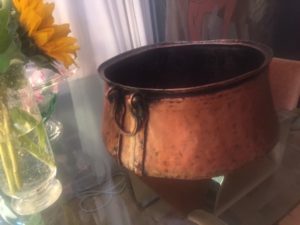 SJ sent me a huge copper pot, 18” diameter, with slanted sides and a curved bottom, with two copper bail handles falling in graceful loops to the sides. These handles are held fast by a double course of raised copper enforcements riveted into the body. This indicates that the pot originally held something either heavy or hot. SJ wants to know country of origin, and usage.
SJ sent me a huge copper pot, 18” diameter, with slanted sides and a curved bottom, with two copper bail handles falling in graceful loops to the sides. These handles are held fast by a double course of raised copper enforcements riveted into the body. This indicates that the pot originally held something either heavy or hot. SJ wants to know country of origin, and usage.
I find copper cookware difficult to date because almost all nations and civilizations USED copper to make food. WHY?
Incredibly Conductive Copper
I turned to no lesser an authority on cooking than Julia Child, who’s Mastering the Art of French Cooking states: “Copper (cookware) is the most satisfactory for holding and spreading heat well.” Try to imagine those gorgeous French sauces without the use of copper cookware.
Copper heats quickly and diffuses evenly, then cools rapidly. All over the world, chefs use copper to sear meat, and cook delicacies that need to reach a specific consistency. Copper ions have a positive effect, stabilizing egg whites and retaining the green in vegetables. Because copper reacts to acid, cooks refrain from adding wine, lemon juice or tomatoes to a bare copper interior.
Thousands of years ago somebody discovered that lining a copper pot with friendly tin solves that acid problem. I say friendly because copper and tin are chemically attracted to each other, and form a lasting bond. The best chefs in France send their tin lined copper pots out to be relined each year, because of tin’s low melting point of 450 degrees and it wears away. The big name in French pots is Mauveil of Normandy, est. 1830.
On a trip to France, Chuck Williams of Williams- Sonoma realized the importance of copper cookware, and established an American line with stainless instead of a tin lining. Stainless stands higher heat, and last longer. Occasionally his pots come with a copper insert to augment the cookware, called a ‘copper core.” Some cooks find this a marketing tool, and not efficient. Stainless doesn’t conduct heat as well as copper, and stainless clad copper, because steel and copper are NOT friendly, can explode at high heats. No natural affinity between copper and steel exists, and the bond must induct chemically, forming a slight division between the metals.
Where did SJ’s copper pot come from?
It didn’t come from France. The French used pots this big for making jams, and jam pots are traditionally NOT lined. I see traces of tin lining at the very bottom. And SJ’s pot has a distinctive shape, not European in style. The rounded bottom contains a clue. A rounded bottom on an old pot means the pot at one time included a stand, a circle of iron surmounting three legs. Cooks used the stand for ‘over the fire’ cooking, not IN the fire. We also know coppersmiths worked their trade worldwide, even early American cooks used handmade pots. Paul Revere worked as a coppersmith!
To geographically place SJ’s pot, I looked for the dovetailing of the joining of the pot in its structure. Copper is worked in sheets, hammered and shaped into a circle. You see the hand hammering on this pot. But at SOME point, usually at the base, a hole is created that will need an insert. That insert, for a good pot, will dovetail into the main body of the pot.
Furthermore, I looked for rivets that go all the way THROUGH the body of the container, hand pounded and not machine made. This points to an 19th century or older pot, although the FORM of the pot could be ancient. The shape points to the Middle East, as well as the size and tradition of slow cooking of meats. Originally SJ’s pot came with a lid. I see the raised lips where the lid fitted, also an indication of slow cooking.
How to care for this copper pot?
SJ wrote that the pot appeared SO BLACK after 30 years in storage that she took her power drill and a stiff brushhead with Bar Keeper’s Friend to the piece. OUCH! The best way to keep that black away (the green verdigris blackens to a rust over time) is to use lemon juice and salt! The value is $400.